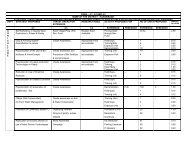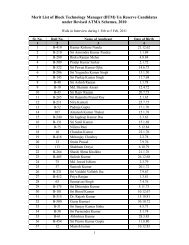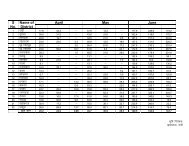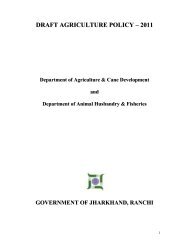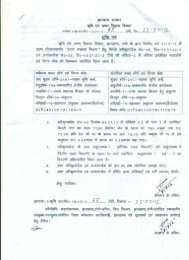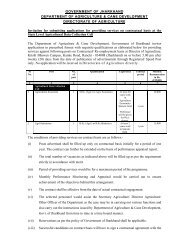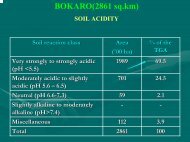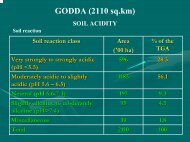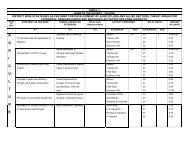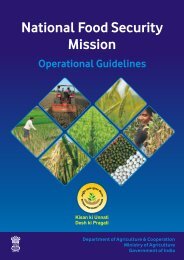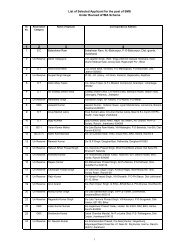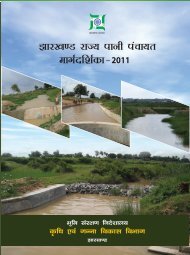Soil Science - Sameti.org
Soil Science - Sameti.org
Soil Science - Sameti.org
You also want an ePaper? Increase the reach of your titles
YUMPU automatically turns print PDFs into web optimized ePapers that Google loves.
<strong>Soil</strong> <strong>Science</strong><br />
clays contain more micro-space. Therefore sands are more porous and do not pose any drainage problem<br />
in spite of its having less total pore space.<br />
Plasticity and cohesion : Plasticity is a soil property which enables a moist soil to change shape on an<br />
applied force and retain this shape even when the force is withdrawn. Thus sandy soils are considered<br />
as non-plastic and clayey soils as plastic. Cohesion, on the other hand, is a property of the particles to<br />
stick to one another by cohessive force. Plastic soils are cohesive. Plasticity and cohesion reflect the<br />
soil consistency and workability of the soils. Black soils are highly plastic and highly cohessive making<br />
tillage operation difficult.<br />
<strong>Soil</strong> temperature : It controls the microbiological activity and all the other plant growth processes. The<br />
role of <strong>org</strong>anic-matter decomposition and the mineralization of <strong>org</strong>anic form of nitrogen increases with<br />
temperature. The amount of <strong>org</strong>anic matter is thus expected to be more in soils with low temperature.<br />
<strong>Soil</strong> temperature is an important factor affecting seed germination, plant growth and microbiological<br />
activity. Germination has been found to be a slow process in a cold soil.<br />
For germination and root growth, the required temperature varies with crops and varieties. The winter<br />
crops, viz. wheat, barley and oat, require low temperature for germination as compared to the summer<br />
crops, viz. cotton and s<strong>org</strong>hum.<br />
The soil colour, composition and the water content influence soil temperature. Dark and fine textured<br />
soils absorb more heat during the day and lose it during night more quickly than the coarse-textured<br />
soils, because the former retain more water and the specific heat of water is 4-5 fold more than that of<br />
the soil particles. The importance of soil temperature may be judged by the fact that <strong>Soil</strong> Taxonomy<br />
has kept a provision for soil temperature to use it as a differentiating criterion at the family level of<br />
categorization.<br />
<strong>Soil</strong> Air : The restricted soil aeration affects root development, respiration and other biological processes<br />
and can thus change the soil environment. The knowledge of soil air and its composition assumes a<br />
greater importance. The pore space, not filled by water, is occupied by space (macropores) and generally<br />
constitutes the air space, the capillary pore space (micropores) being occupied by water. Normally if<br />
one-third of the pore space in the soil is filled by air and two-thirds by water, the plant growth is assumed<br />
to be optimum.<br />
The soil air composition is controlled by a balance between two competing processes. The consumption<br />
of oxygen and a concomitant release of carbon-dioxide by plant roots and the soil <strong>org</strong>anisms tend to<br />
increase the differences in the composition of the soil air and the atmosphere above the soil surface.<br />
Gaseous diffusion tends to reduce the difference in composition. The measurement of aeration status in<br />
soil has been reported as oxygen diffusion rate which determines rate of oxygen replenishment due to its<br />
continuous consumption by plant roots and micro-<strong>org</strong>anism. The growth of most of the plants is affected<br />
when oxygen diffusion rate is less than 20 x 10 -8 g/cm 2 per minute.<br />
The atmospheric air has nearly 21% O 2<br />
, 0.035% CO 2<br />
and more than 78% N 2<br />
and the soil air is also<br />
composed largely of nitrogen and oxygen, but differs from former in containing more moisture, more<br />
carbon-dioxide and a little less oxygen (Table 7.4). The content of carbon-dioxide varies during the crop<br />
season due to higher rates of crop growth and microbiological activities in the soil.<br />
8 Reading Materials for Village Level Workers




